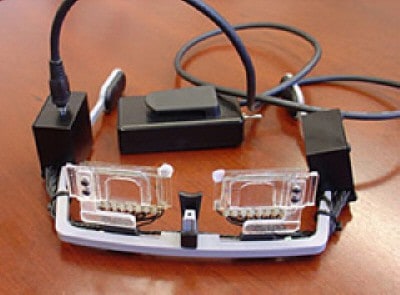Do you wear bifocal spectacles and get frustrated at having to move your gaze between the upper and lower lenses as you switch from far to near vision? If so, help could soon be at hand thanks to a new lens developed by optical scientists in the US. It consists of a layer of liquid crystal sandwiched between two glass surfaces, the focusing power of which can be changed by altering the voltage applied to the lens. Although the lens has to be manually switched on and off to change focus, the researchers say the work could lead to lenses that automatically adjust their focus depending on where the user is looking (Proc. Natl. Acad. Sci. to be published).

As we get older, our eyes become less flexible and often lose their ability to shift focus from distant to near objects. This phenomenon, known as presbyopia, is thought to affect over 90% of the population. Bifocal lenses, which contain two different areas of glass, are a common solution. However, users still need to move their gaze between the upper and lower lenses as they switch from looking at distant to near objects. Moreover, looking downwards through the lens can make you dizzy and give you a headache.
Guoqiang Li and colleagues of the University of Arizona and co-workers at the Georgia Institute of Technology have now developed a lens that overcomes these problems. It consists of a flat, 5-micron thick layer of liquid crystal sandwiched between two layers of glass that are coated with concentric rings of tiny, transparent indium-tin-oxide electrodes.
When the lenses are “off” and no field is applied, the lens can be used to look at distant objects. But applying a voltage of less than 2V to the electrodes changes the orientation of the liquid-crystal molecules, which in turn alters the refractive index of the crystal. This allows the lens to switch its focusing power, and become less magnifying, so that a near object can be viewed almost immediately (figure 2). When the voltage is removed, the lens reverts to its original non-focusing configuration, which also means that it is safe to use for far-vision activities — such as driving — should the power source fail.
Li and colleagues have found that their lens performs well for both near- and distant-vision tasks by testing prototype glasses. At present, the applied voltage needs to be switched on and off for the lens to change focus but ultimately the device will work automatically, “like an auto-focusing camera” say the researchers. This is because the device will contain a “range finder” like in a camera. And although the glasses are not exactly the height of fashion, the researchers hope that industry will design better looking adjustable-focus lenses for the future.




